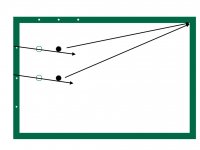What is laughable is that some people still hold onto the belief that the earth is flat, even when science allows us to prove that it is round beyond any and all doubt, just because "it sure looks flat to me when I look out on the horizon." What is also laughable is that some people still hold onto the belief that systems like this as well as all the CTE variants are physically sound systems, even when science allows us to prove that they are not beyond any and all doubt, just because "well I make balls when I do it so it must be physically sound."
You got that right, and it is beyond obvious if anyone takes two seconds to really think about what is actually happening when you aim the left or right side of the shaft at the contact point on the object ball for different cut angle shots.
Yes, it requires user aiming adjustments (just like CTE) which can easily be done subconsciously.
Ding, ding, ding, we have a winner. It doesn't work on paper, just like CTE, because it is not a physically sound system. In spite of not being physically valid, just like with CTE, it "works" because your mind makes subconscious aiming adjustments based on experience, because it removes shot anxiety and makes you stroke more confidently because of your belief in the system, and because with the system you are concentrating more and are more focused on the object ball than you normally would have been.
Ding, ding, ding, another winner. Just like with CTE, everybody KNOWS it can't physically work, but since they still see positive benefits from using it, they would rather lie to themselves and claim that it must somehow be physically valid instead of just embracing the truth that it "works" for other reasons and just being happy enough with their improvement no matter what the reason. It's the old "the earth sure looks flat, so it must be flat and I'm not going to let anybody tell me otherwise," mentality. "But I can see it with my own eyes, it's flat!!" "But I make balls when I do it, it's physically valid!!"
